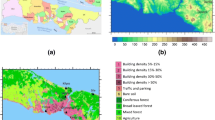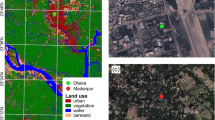Abstract
The characteristics of the urban heat island effect and the climate change in Shanghai and its possible mechanism are analyzed based on monthly meteorological data from 1961 to 1997 at 16 stations in Shanghai and its adjacent areas. The results indicate that Shanghai City has the characteristics of a heat island of air temperature and maximum and minimum air temperature, a cold island of surface soil temperature, a weak rainy island of precipitation, and a turbid island of minimum visibility and aerosols, with centers at or near Longhua station (the urban station of Shanghai). Besides theses, the characteristics of a cloudy island and sunshine duration island are also obvious, but their centers are located in the southern part of the urban area and in the southern suburbs. A linear trend analysis suggests that all of the above urban effects intensified from 1961 to 1997. So far as the heat island effect is concerned, the heat island index (difference of annual temperature between Longhua and Songjiang stations) strengthens (weakens) as the economic development increases (decreases). The authors suggest that the heating increase caused by increasing energy consumption due to economic development is a main factor in controlling the climate change of Shanghai besides natural factors. On the other hand, increasing pollution aerosols contribute to the enhancement of the turbid island and cooling. On the whole, the heating effect caused by increasing energy consumption is stronger than the cooling effect caused by the turbid island and pollution aerosols.
Similar content being viewed by others
References
Chen Longxun, Li Weiliang, Zhu Wenqin, and Zhou Xiuji, 2000: Characteristics of environmental and climate change in Changjiang Delta and its possible mechanism.Acta Meteor. Sinica,14(1), 129–140.
Deng Ruru, Tian Guoliang, Wuang Xuemei, and Cheng Xaoxang, 2002: Quantitative remote sensing for synthetic aerosol and its application in Shanghai district. SPIE’s Third International Asia-Pacific Environmental Remote Sensing Symposium, July 2002, Hangzhou, China, 125–129.
Ding Jincai, and Ye Qixin, 2002: The influence of the heat island effect on the forecasting and the diagnostic analysis of the high temperature in summer of Shanghai.Developing Strategy of Atmospheric Sciences, edited by China Meteorological Society, China Press, Beijing, 191–194. (in Chinese)
Ding Jingcai, Zhang Zhikai, Xi Hong, and Zhou Hongmei, 2002: A study of the high temperature distribution and the heat island effect in the mid-summer of the Shanghai area.Chinese Journal of Atmospheric Sciences,26(3), 412–420.
IPCC, 2001:The Scientific Basis. Contribution of Working GroupI to the Third Assessment Report of IPCC, Cambridge University Press, 881pp.
Jones, P. D., P. Ya. Groisman, M. Coughlan, N. Plummer, W.-C. Wang, and T. R. Kar, 1990: Assessment of urbanization effects in time series of surface air temperature over land.Nature,347(2), 169–172.
Karl, T. R., H. F. Diaz, and G. Kukla, 1988: Urbanization: Its detection and effect in the United States climate record.Journal of Climate,11(8), 1099–1123.
Oke, T. R. (Ed.), 1984: Proceedings of the Technical Conference: Urban climatology and its applications with special regard to tropical areas WMO No. 652. W. M. O., Geneva.
Peterson, T. C., K. P. Gallo, J. Lawrimore, T. W. Owen, A. Huang, and D. A. McKittrick, 1999: Global rural temperature trend.Geophysical Research Letters,26(3), 329–332.
Yan Jiyuan, and Xu Jialiang, 1996:Climate in Shanghai, China Meteorological Press, Beijing, 249pp. (in Chinese)
Zhou S. -Z., 1991: Formation of fog and its characteristics in Shanghai.Quart. J. Appl. Meteor.,2(3), 256–263. (in Chinese)
Zhou S. -Z., and Wu, L., 1987: Underlying surface temperature of Shanghai and urban heat island.Acta Scientiae Circumstantiae,7(3), 261–267. (in Chinese)
Zhou S. -Z., and coauthors, 1988: Turbid island effect of Shanghai City.Scientia Geographica Sinica,8(4), 305–312. (in Chinese)
Zhou Shuzhen, and Shu Tong, 1994:Urban Climatology. China Meteorological Press, Beijing, 618pp. (in Chinese)
Author information
Authors and Affiliations
Corresponding author
Rights and permissions
About this article
Cite this article
Longxun, C., Wenqin, Z., Xiuji, Z. et al. Characteristics of the heat island effect in Shanghai and its possible mechanism. Adv. Atmos. Sci. 20, 991–1001 (2003). https://doi.org/10.1007/BF02915522
Received:
Accepted:
Issue Date:
DOI: https://doi.org/10.1007/BF02915522




